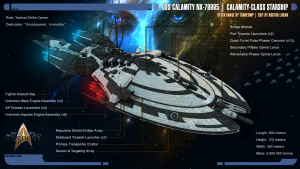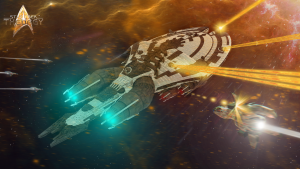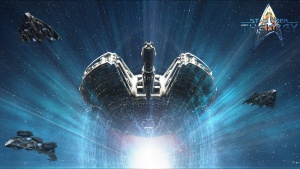USS Calamity: Difference between revisions
From Star Trek: Theurgy Wiki
Auctor Lucan (talk | contribs) No edit summary |
Auctor Lucan (talk | contribs) No edit summary |
||
| Line 12: | Line 12: | ||
|- | |- | ||
| Starship Type: | | Starship Type: | ||
| Tactical Strike | | Tactical Strike Carrier | ||
|- | |- | ||
| Status: | | Status: | ||
Revision as of 00:07, 6 August 2016

| |
| Vessel Name: | USS Calamity |
| Registry: | NX-79995 |
| Starship Class: | Calamity-class |
| Starship Type: | Tactical Strike Carrier |
| Status: | Destroyed year 2381 |
| Purpose: | Seek & Destroy |
| Constructed: | Antares Fleet Yards & Utopia Planitia Fleet Yards |
| Commissioned: | Unknown (Temporal Anomaly) |
| Dedication: | ”Unconquered. Invincible." |
| Dimensions: |
|
| Mass: | 2,600,000 tonnes |
| Decks: | 27 |
| Standard Crew Complement: | 0 organics; 46 holographic crew |
| Impulse Engine: | Unknown Impulse Engine Assembly (6 vanes) |
| Warp Engine | Unknown Warp Engine Assembly (2 nacelles in SOM) |
| Armaments: |
|
| Defences: |
|
| Auxiliary Craft |
|

| |
The Calamity-class was designed as a successor ship to the Theurgy-class vessel in the early 25th century, taking many of the same innovations present from it's ancestor and improving upon them for a superior class of starship.
Description
While the Theurgy was designed with combat in mind, the Calamity better embodies the concept of a warship, in particular being seen as a Hunter, capable of tracking targets over a long distance and overwhelming them in speed and combat prowess. To make this possible, a number of factors were taken into account with the Calamity. Firstly, it's size was reduced from that of the Theurgy, allowing for an increase in the thickness of the ablative hull armour without sacrificing additional weight that would slow the vessel down at warp speeds. This reduction in size also saw the removal of additional cargo bays, and a reduction of shuttle crafts and runabouts, while making room for some additional warp fighters.
The most significant change to the armaments of the USS Calamity was the inclusion of Repulsive Shielding, developed shortly before the ship's construction in the 25th century. The concept of the shielding was to disperse the incoming fire and subsequent damage through oscillation of the shields, creating a ripple effect that spread the impact out to reduce the overall magnitude. In practical studies, this was shown to reduce energy loss by 35%. It also improved shielding near the front and back, where the shield bubble was less pronounced. Impact with these areas actually saw a 50% decrease in shield energy loss as the thinner surface area actually saw some of the blast spread off the shields entirely into empty space.
USS Calamity, piloted by a purely holographic crew, was able to function without a need for rest, making her a relentless pursuer.
Phaser Spinal Lance
Developmental history of the Phaser Spinal Lance began with the Tetryon Pulse Cannon on the AC-409 Mk III Valkyrie.
In the timeline unaffected by the parasites of the 24th century, around the year 2489 Starfleet, R&D began tests to attempt to have a phaser fire as a beam rather than a pulse canon. The result had the inadvertent effect of having a concentrated Phaser beam fired with a residual cone of tetryon particles around it. The excited techs began further testing, honing the weaponry in round after round of initial studies. An exciting benefit was found, in that it was discovered that the damage this weapon caused was also a partial bypassing of shields and a concentrated burn from phaser fire on the target hull. It was established that it was too bulky and consumed too much power in that incarnation however, so the scientist set about refining the weapon, now that the proof of concept had been finished.
The Type 2 tetryon canon was the result of this, creating a weapon which was able to partially bypass shields and deal limited direct phaser damage to a hull. This type was still too bulky for a Fighter size craft which could not contain the necessary power generators to fully test the limits this weapon system had to offer.
The Type 3 tetryon canon prototype was forward mounted. Directly forward firing, this phaser beam was located on the underside of a starship's hull. It had to draw power directly from the power generators of its warp engines, so energy consuming was it. And while this weapon was capable of decent shield penetration, it suffered from poor performance against ablative and energy deflecting armours as well as having a slow firing rate. It also was plagued with malfunction issues that caused the engines to blow coolant storage cells.
In light of the issues the Type 3 had, a second attempt was spearheaded by the advanced starship design bureau named Project Lancelot. The goal of this project was to create a semi mobile weapons platform built around the use of what the Type 3 was theoretically capable of.
The USS Lancelot was a heavily modified saucer section from a Galaxy class vessel, the former USS Enterprise D. Mounted to it was the newly created Type 4 Cannon, which operated by creating a massive burst of tetryon particles that coned around a concentrated phaser beam. The particles in question weakened the target’s shields to the point of localised shield collapse. The phaser beam itself then pierced directly into the hull and was of such high heat that it was capable of piercing all the way through most ships hulls. High heat resistant armours, energy deflecting armours, and ablative armours tended to absorb enough of the phaser energy to prevent full penetration however. Tactical doctrine thus called for torpedoes to be fired in concert with the Tetryon Pulse Phaser to effectively damage these.
The Lancelot platform required major changes to the Galaxy class saucer section to effectively use this weapon. The most visually striking of these changes were the attachment of a warp nacelle and deflector dish which were installed on the top and bottom of the section via central pylons evoking similarities to some 23rd century Federation survey vessels like the Cheyanne class starship. This warp core system rather than as a means of propulsion, was instead required to provide the necessary power for the weapons system and the deflector dish was as an assisting system for the weapons aiming systems. As a result the phaser shot was less a traditional phaser blast but a concentrated beam of warp Plasma. The major downside to this awe inspiring weapon however was that it took too long to rebuild the necessary energy to fire its next shot.
During the 2490’s the Type 4 Cannon was approved for military service and renamed, now being known as the Phaser Spinal Lance. The weapon was used on new classes of Starfleet vessels as well as upgrades to selected Galaxy, Nebula, and Sovereign class starships.
In the current timeline, however, when the parasitic usurpers overtook Starfleet Command, it is largely unknown how the Phaser Spinal Lance technology became installed in the USS Calamity, but it likely had something to do with a faction in the Temporal Cold War.
Ship A.I. Hologram
Biography:
Unknown. No records found in the database.
Personality Profile:
Unknown. No records found in the database.
Physical Description:
Unknown. No records found in the database.




